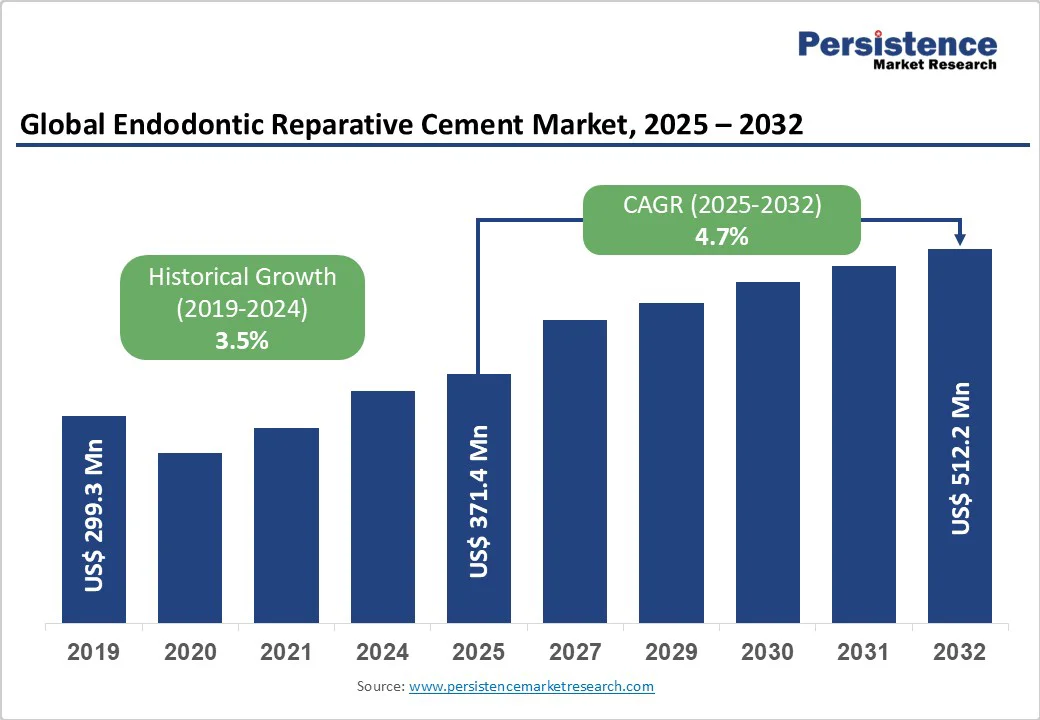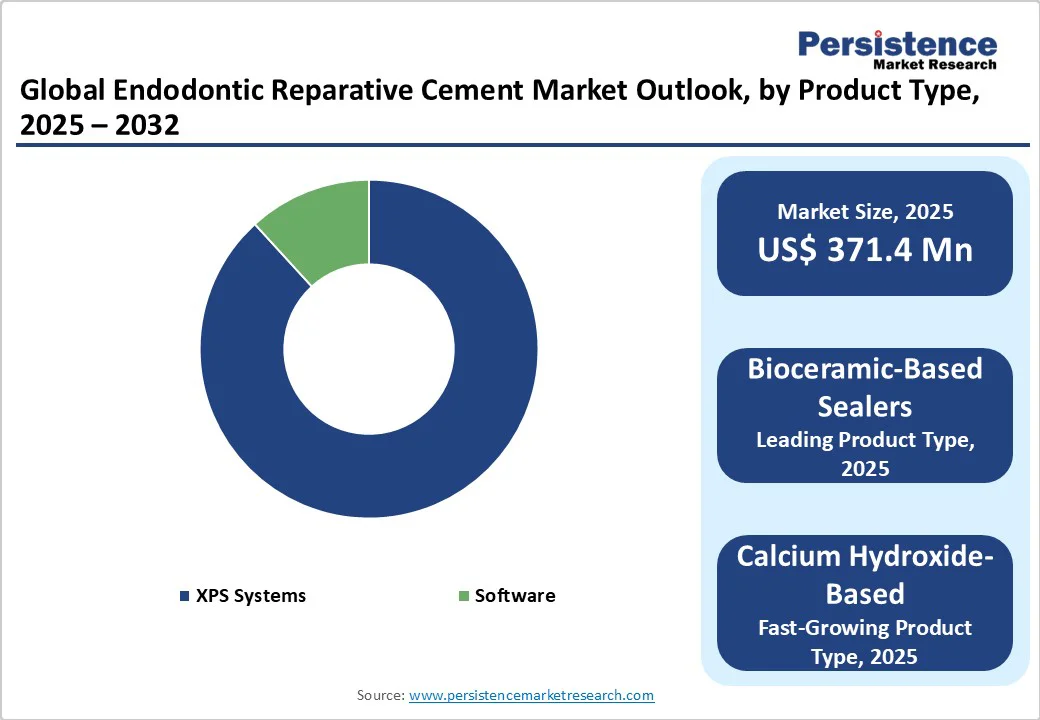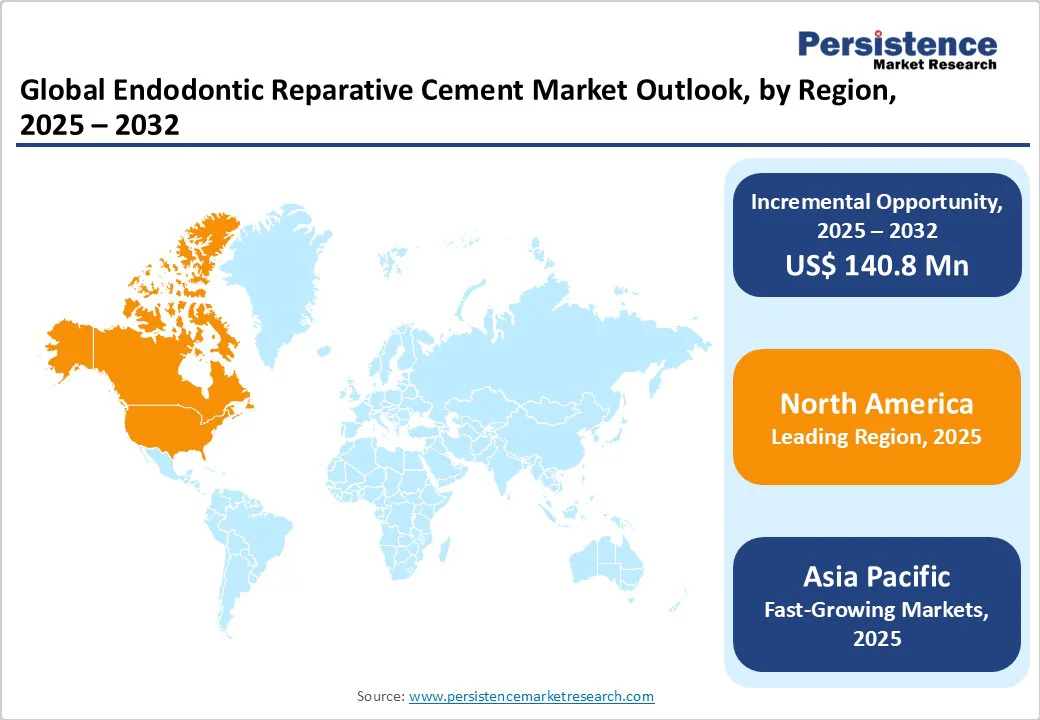ID: PMRREP20839| 185 Pages | 29 Sep 2025 | Format: PDF, Excel, PPT* | Healthcare

The global endodontic reparative cement market is likely to value US$ 371.4 Mn in 2025 and is projected to reach US$ 512.2 Mn by 2032 growing at a CAGR of 4.7% during the forecast period from 2025 to 2032, driven by rising dental disorders, increasing root canal procedures, and demand for bioceramic materials.
| Key Insights | Details |
|---|---|
| Global Endodontic Reparative Cement Market Size (2025E) | US$ 371.4 Mn |
| Market Value Forecast (2032F) | US$ 512.2 Mn |
| Projected Growth (CAGR 2025 to 2032) | 4.7% |
| Historical Market Growth (CAGR 2019 to 2024) | 3.5% |

Due to its high sealing ability and biocompatibility, mineral trioxide aggregate (MTA) has gained a lot of attention as an endodontic repair filling material. MTA has poor handling properties, despite having a superior sealing ability than conventional endodontic repair filling materials like calcium hydroxide.
Recently, a brand-new endodontic repair filling material with a comparable chemical makeup and enhanced handling properties was developed. It has also been asserted, that BioAggregate repair filling materials are biocompatible, encourage cementogenesis, and create a tight seal within the root canal. More recently, the industry was introduced to Biodentine & EndoSequence endodontic restorative materials.
Additionally, the fact that healthcare costs for any particular procedure or product in case are reimbursed is a major factor in the increase in the percentage of individuals seeking dental treatment over time. The average Medicaid compensation for children is 61.8 percent, and the average Medicaid reimbursement for adults is 46.1%, for endodontic treatment procedures. Healthy reimbursement scenarios are a compelling marketing tactic to draw in new customers.
Because of their relationships with the businesses and their knowledge of the specifics of their products, the insurance firms are able to develop carefully thought-out reimbursement incentives for consumers while still preserving healthy profit margins.
Although the composition of mineral trioxide aggregate (MTA) has undergone various changes, MTA still has some drawbacks, including tooth discolouration, manipulation issues, a prolonged setting time, and the discharge of heavy metals. The lengthy setting time is another drawback that prevents the clinical use of bioactive endodontic cements.
Moreover, difficulties handling in a medical setting, and its ageing or biodegradation tendency once applied, which leads to undesirable dental discolorations, are additional drawbacks of using MTA.
Furthermore, a variety of materials, including amalgam, zinc phosphate cement, and gold foil, have been employed as retrograde fillings in the past. However, several innovative materials have been developed for retrograde filling due to their shortcomings, such as marginal leaking, lack of resistance to corrosion, and sensitivity to periapical tissues.
In some locations, there is also a lack of integration of oral health strategies with general health promotion initiatives. This is mainly seen in areas with little healthcare spending; oral health is typically one of the last provisions to be included to legislation that is passed by governments.
Therefore, an even greater number of individuals would be affected by the rising cost of dental care. Limited access to dental care is greater in low and middle-income nations. Such restrictions limit the ability of the producers to increase their regional presence while also affecting the market's overall potential.
Bioceramic materials offer a strong opportunity in the endodontic reparative cement market because of demonstrated high success rates in root canal therapies and increasing global burden of oral disease. A meta-analysis showed that endodontic treatments of teeth with vital pulp had cumulative success rates of ≈82.8%, and for non-vital pulp ≈78.9% when using appropriate sealing and obturation techniques. Long-term follow-ups over 20-30 years report survival of treated teeth at 81-93% after 10-20 years, underlining the importance of durable sealants and cements.
WHO estimates that 2.5 billion people suffer from untreated dental caries globally, highlighting huge unmet need for restorative and reparative dental materials. Bioceramics are biocompatible, bioactive, and can enhance sealing, reduce microbial leakage, and improve long-term outcomes; hence innovations in this subsegment are likely to capture growing demand as clinicians seek materials that improve success and longevity.
The bioceramic-based sealers segment held around 45.8% of the total market in 2025. The improved physical, chemical, and biological qualities of bioceramic-based sealers over conventional endodontic sealers led to their introduction in endodontics.
Root canal sealants made of bioceramic material are regarded as a useful endodontic technique. Humans frequently employ bioceramics for replacement and repair, and they boast powerful bioconductive and bioinductive qualities.
The purpose of developing these materials was to make them universally applicable and biocompatible with human tissue. Either they can operate as human tissues or they can resorb and promote the regeneration of healthy tissues.
Root canal obturation held a share of about 73.4% in 2025. All of the current obturating methods use a sealer to strengthen the seal of the endodontic filling material. Sealants for root canals are the binding agents used to cover the gap between the obturating materials and the root canal walls.
A sealer's primary function is to cover the gaps between both the core material and the root canal walls, in addition to between the gutta-percha cones, in an effort to construct a cohesive mass of obturating material free of spaces.
To stop microbes and bacterial toxins from entering the endodontic system, the root canal system is obturated utilizing a tight seal. Owing to these factors, the segment holds a larger share in the global market, and is expected to continue to do so, over the forecast period.

In North America, endodontic treatments are common: a U.S. cohort study found about 13% of dentate adults received at least one endodontic procedure over 4 years, with root canal therapy making up ~94% of those procedures. The same region shows that about 5.5% of teeth in an American dental school sample had root fillings; periapical disease was observed in 4.1% of all teeth and 31.3% of root-filled teeth.
Growing awareness of oral health adds urgency: 21% of U.S. adults aged 20-64 have at least one untreated cavity, per CDC data. At the same time, professional societies like the American Association of Endodontists are increasing adoption of bioceramic sealers and hydraulic cements, citing benefits such as bioactivity, superior sealing, and fewer esthetic issues compared to older materials.
Europe is a major region, holding a 28.6% global share in 2025, Germany is the leading country in this region with 26.2 % share in Europe in 2025, The WHO European Region reported that 50.1% of adults had a major oral disease in 2019, including the highest global rates of caries of permanent teeth (~33.6% of the population), equating to almost 335 million cases.
Untreated caries remains the most prevalent oral condition across Europe, affecting about one in three people for permanent dentition. A meta-analysis found that in Europe around 9.3% of people have had at least one root-filled tooth, indicating substantial demand for sealers and reparative materials used in root canal therapy.
Meanwhile, procedural quality gaps persist: a Finnish study showed only 52% of root canal fillings were technically optimal (in terms of length, voids, etc.). These trends combine high disease burden, rising demand, and needs for materials that improve treatment success, positioning bioceramic and advanced reparative cements as a growth area.
Asia Pacific is emerging as one of the fastest-growing regions for endodontic reparative cements due to its high oral disease burden and increasing dental care access. WHO estimates show that in the Western Pacific, 800 million people (42% of the population) live with oral diseases such as untreated caries and periodontal conditions.
In South-East Asia, untreated dental caries affects 43.8% of children and nearly 29% of people over five years. India alone performs 15 million root canal treatments annually, averaging 41,000 daily. Rising dental tourism in countries like Thailand and India, alongside adoption of bioceramic sealers for higher success rates, further strengthens regional growth.

The global endodontic reparative cement market is fragmented. Manufacturers pursue sales enhancement techniques such as mergers and acquisitions, infrastructure investments, product releases, and the adoption of innovative technology-based products. In order to regulate the value chain, manufacturers are also emphasising forward integration through collaborations with wholesalers, distributors, and other channel partners.
Through improvements in distribution channels, the use of analytics for the computation of treatment effectiveness correlations and gains through competitive pricing is increasing. In order to increase their market share, businesses frequently bundle or combine services with products while using online sales to offer discounts.
The global market is projected to be valued at US$ 371.4 Mn in 2025.
The global endodontic reparative cement market is driven by rising dental disorders, bioceramic innovation, dental tourism, and growing oral healthcare awareness.
The Global market is poised to witness a CAGR of 4.7% between 2025 and 2032.
Key opportunities include bioceramic advancements, rising dental tourism, digital dentistry integration, growing demand in emerging markets, and minimally invasive treatment trends.
Major players in the global are Dentsply Sirona, Septodont Holding, Ivoclar Vivadent, Ultradent Products Inc., Kerr Dental and others.
| Report Attribute | Details |
|---|---|
| Historical Data/Actuals | 2019 - 2024 |
| Forecast Period | 2025 - 2032 |
| Market Analysis | Value: US$ Mn |
| Geographical Coverage |
|
| Segmental Coverage |
|
| Competitive Analysis |
|
| Report Highlights |
|
By Product
By Indication
By End-user
By Region
Delivery Timelines
For more information on this report and its delivery timelines please get in touch with our sales team.
About Author